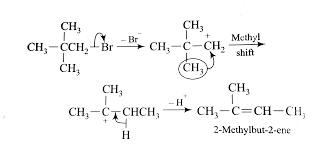
The dehydrohalogenation of neopentyl bromide with alcoholic KOH mainly gives
A) 2-methyl-1-butene
B) 2-methyl-2-butene
C) 2, 2-dimethyl-1-butene
D) 2-butene
Answer
351k+ views
Hint: The dehydrohalogenation reaction is a type of elimination reaction. In this reaction a carbocation is formed as an intermediate which further reacts to give an alkene.
Complete Step by Step Answer:
When an alkyl bromide is treated with an alcoholic base then an elimination reaction takes place.
In this reaction at first step the halogen atom that is bromine atom is removed from the alkyl halide that is neopentyl bromide to form a carbocation intermediate that is neopentyl carbocation in reaction with an alcoholic base that is potassium hydroxide.
In the next step one methyl group is shifted to the next carbon atom due to unavailability of beta hydrogen. Now the newly formed carbocation contains beta hydrogen and the beta hydrogen is easily removed and forms the desired product that is 2-methyl-2-butene. In this reaction hydrogen bromide is removed as a side product.

Thus the dehydrohalogenation of neopentyl bromide with alcoholic KOH mainly gives 2-methyl-2-butene as a major product.
Thus the correct option is B.
Note: In general E1 elimination reaction no shifting of any group takes place. If no beta hydrogen is present in the produced intermediate that is the carbocation then shifting of a group takes place to generate beta hydrogen which helps to produce the desired product.
Complete Step by Step Answer:
When an alkyl bromide is treated with an alcoholic base then an elimination reaction takes place.
In this reaction at first step the halogen atom that is bromine atom is removed from the alkyl halide that is neopentyl bromide to form a carbocation intermediate that is neopentyl carbocation in reaction with an alcoholic base that is potassium hydroxide.
In the next step one methyl group is shifted to the next carbon atom due to unavailability of beta hydrogen. Now the newly formed carbocation contains beta hydrogen and the beta hydrogen is easily removed and forms the desired product that is 2-methyl-2-butene. In this reaction hydrogen bromide is removed as a side product.

Thus the dehydrohalogenation of neopentyl bromide with alcoholic KOH mainly gives 2-methyl-2-butene as a major product.
Thus the correct option is B.
Note: In general E1 elimination reaction no shifting of any group takes place. If no beta hydrogen is present in the produced intermediate that is the carbocation then shifting of a group takes place to generate beta hydrogen which helps to produce the desired product.
Recently Updated Pages
Questions & Answers - Ask your doubts

A man running at a speed 5 ms is viewed in the side class 12 physics CBSE

State and explain Hardy Weinbergs Principle class 12 biology CBSE

Which of the following statements is wrong a Amnion class 12 biology CBSE

Two Planoconcave lenses 1 and 2 of glass of refractive class 12 physics CBSE

The compound 2 methyl 2 butene on reaction with NaIO4 class 12 chemistry CBSE

Trending doubts
What is BLO What is the full form of BLO class 8 social science CBSE

Differentiate between an exothermic and an endothermic class 11 chemistry CBSE

Which places in India experience sunrise first and class 9 social science CBSE

The shortest day of the year in India

What are the major means of transport Explain each class 12 social science CBSE

Which are the Top 10 Largest Countries of the World?




